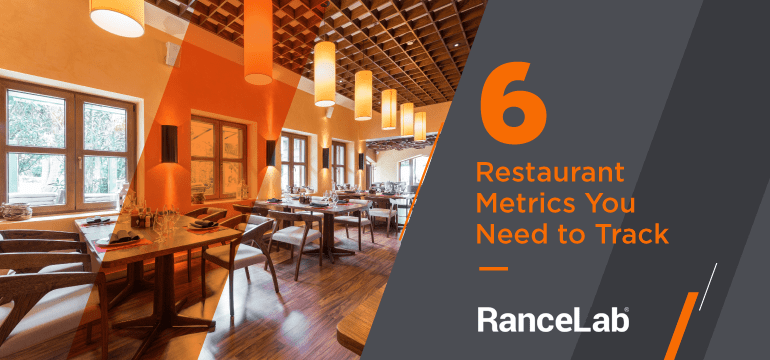For your restaurant to be successful, it takes more than having a ravishing ambience or a lip-smacking menu. A well-dressed and courteous staff may help, and so might the choicest selection of cocktails. However, if you are not tracking and evaluating your restaurant’s performance based on a number of criteria, you simply will not achieve the success or growth you aspire to. Quantifying and objectively assessing a restaurant’s performance based on a number of parameters and metrics is important to make important administrative and operational changes. Restaurant metrics help you to objectively assess your restaurant’s performance, and understand your weaknesses, strengths, and key areas that need attention.
In this article, let us take a look at 6 important metrics you need to start tracking immediately.
1. Break-even Point
A break-even point is one of the most important restaurant metrics. It helps you assess how much revenue is required to cover your expenses, and helps you assess if you are spending more than what you should be.
How to calculate?
- Subtract Total Variable Costs from your Total Sales figure.
- Divide the difference by Total Sales.
- Divide the Total Fixed Costs by the quotient.
The quotient you arrive at is the Break-even Point.
When you have the Break-even point in your hand, it helps you to assess where you are spending too much, and where that expenditure can be diverted to maximize table turnover.

2. Restaurant Prime Costs
Another important metric is restaurant Prime Costs, which helps you estimate all the money and manpower you need to run your restaurant. With this metric, you will be better prepared for expenses, and will also be able to estimate your profits in advance.
Here is how to calculate it:
- Calculate your cost of goods sold (CoGS).
- Calculate your labor costs.
- Add your CoGS and labor costs to get prime cost.
This metric should be calculated monthly so that every time you have something new to purchase for your restaurant, you will have a handy estimate. Many restaurants do not calculate this important metric, and incur unintended restaurant expenditures.
3. Menu Item Profitability
If you thought everything on your menu was created equally, you are wrong. A few items are ordered more often than the others, and knowing which item is more popular helps you purchase the required ingredients in advance. Menu Item Profitability is an important metric that helps you understand which menu items are bringing you profits.
Calculate Menu Item Profitability
- First calculate the number of items sold.
- Multiply this by the menu price.
- Now, also multiply the number of items sold by the item portion cost.
- Subtract the second product by the first, and you will find your Menu Item Profitability.
Menu Item Profitability can be used to get rid of lower performing items off the menu, which results in a better performing menu.

4. Table Turnover Rate
A table turnover figure helps you to prepare yourself for more diners, and for the next incoming patrons. It also helps you to inform your guests about wait-times so that they can schedule if they choose to. If table turnover rate is consistent, you can attribute this to your staff’s performance, and incentivize them as well.
- Calculate the number of guests served in a day.
- Calculate the number of seats.
- Divide the number of seats by the number of guests, and you will find your Table Turnover Rate.
If you manage to turn your tables at least twice during an evening, that means your restaurant is performing quite well.
5. Customer Retention Rate
With restaurant discovery apps abound, it is not hard to find new customers. However, retaining them after they visit once is very important for your restaurant to succeed. Customer Retention Rate helps you to see where you are going right, and where you are going wrong, because everything that you do right can be attributed to Customer Retention Rate.
To calculate Customer Retention Rate
- Find the difference between your total customers and total new customers.
- Divide the difference by total customers.
- Multiply this product by 100 to get your Customer Retention Rate.
Customer Retention Rate also provides valuable insight about effective how your customer service is, and what you can do to enhance another important restaurant metric, Customer Satisfaction score (CSAT).
6. Gross Profit Margin
Probably the most important of all restaurant metrics, and also the most attractive metric to track, you should pay more attention to your Gross Profit Margin. While gross profit refers to the amount of money you make after deducting all the expenses, Gross Profit Margin can also be represented as a percentage.
To calculate Gross Profit Margin
- First, calculate Gross profit. Subtract the cost of goods sold (CoGS) from your total revenue.
- Once you have a Gross Profit figure, multiply it by 100 to get Gross Profit Margin.
How does it help?
Gross Profit Margin above 70% is a sign of successful restaurant performance. This figure helps you evaluate how much capital you have further expenditure, and how you can use that to make better investments.
Use technology to calculate and track metrics
While there are a number of other restaurant metrics you need to pay attention too, these six metrics are closely linked to your restaurant performance and gross profits. You can use restaurant POS to calculate these metrics as well, so that you are continuously in charge of how well your business is performing.






Leave a Reply
You must be logged in to post a comment.